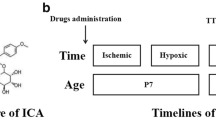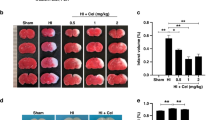Abstract
Perinatal hypoxia-ischemia remains the most important cause of brain injury in the newborn. However, there is still no effective cure for neonatal hypoxic-ischemic brain damage (HIBD). In the present study, we aimed to examine the neuroprotective effects of Shenfu injection (SFI) on HIBD of neonatal rat. Sprague–Dawley rats were divided randomly into three groups (n = 8): S group: the rats were sham operated; C group: the rats were operated for HIBD modeling and received intraperitoneal injection of saline; SFI group: the rats were operated for HIBD modeling and received intraperitoneal injection of SFI (10 ml/kg days) for 7 days. Flow cytometry analysis showed that apoptosis rate of neuron in hippocampal CAI region in SFI group was significantly less than in NC group at 3 and 7 days after HI insult (P < 0.05). Immunohistochemical staining demonstrated that Bcl-2 expression was markedly higher while Bax expression was significantly lower in SFI group than in the C group at 24, 72 h and 7 days after HI insult (P < 0.05). Our findings suggest that SFI exhibits neuroprotective effects for neonatal hypoxic-ischemic brain injury by preventing neuron apoptosis and has potential to be used in the clinical for the treatment of perinatal hypoxia-ischemia.


Similar content being viewed by others

References
Rees S, Harding R, Walker D (2011) The biological basis of injury and neuroprotection in the fetal and neonatal brain. Int J Dev Neurosci 29:551–563
Zhang MY, Ji XF, Wang S, Li CS (2012) Shen-Fu injection attenuates postresuscitation lung injury in a porcine model of cardiac arrest. Resuscitation 83:1152–1158
Kaindl AM, Sifringer M, Koppelstaetter A et al (2008) Erythropoietin protects the developing brain from hyperoxia-induced cell death and proteome changes. Ann Neurol 64:523–534
Cao J, Zhang CD, Zhang GX, Zhang YJ, Min S (2005) Protective effect of Shenfu injection on myocardial mitochondria injured by ischemia-reperfusion in rabbits. Chin Med J 118:505–507
Pimentel VC, Pinheiro FV, Kaefer M et al (2011) Assessment of uric acid and lipid peroxidation in serum and urine after hypoxia-ischemia neonatal in rats. Neurol Sci 32:59–65
Gill MB, Perez-Polo JR (2008) Hypoxia ischemia-mediated cell death in neonatal rat brain. Neurochem Res 33:2379–2389
Nah SY, Kim DH, Rhim H (2007) Ginsenosides: are any of them candidates for drugs acting on the central nervous system? CNS Drug Rev 13:381–404
Tu LH, Ma J, Liu HP, Wang RR, Luo J (2009) The neuroprotective effects of ginsenosides on calcineurin activity and tau phosphorylation in SY5Y cells. Cell Mol Neurobiol 29:1257–1264
Zhang HA, Wang M, Zhou J, Yao QY, Ma JM, Ji CL (2010) Protective effect of ginsenoside against acute renal failure and expression of tyrosine hydroxylase in the locus coeruleus. Physiol Res 59:61–70
Ekert P, MacLusky N, Luo XP et al (1997) Dexamethasone prevents apoptosis in a neonatal rat model of hypoxic-ischemic encephalopathy (HIE) by a reactive oxygen species-independent mechanism. Brain Res 747:9–17
Romijn HJ, Hofman MA, Gramsbergen A (1991) At what age is the developing cerebral cortex of the rat comparable to that of the full-term newborn human baby? Early Hum 26:61–67
Almli CR, Levy TJ, Han BH, Shah AR, Gidday JM, Holtzman DM (2000) BDNF protects against spatial memory deficits following neonatal hypoxia-ischemia. Exp Neurol 166:99–114
Jansen EM, Low WC (1996) Long-term effects of neonatal ischemic–hypoxic brain injury on sensorimotor and locomotor tasks in rats. Behav Brain Res 78:189–194
Yang JP, Liu HJ, Yang H, Feng PY (2011) Therapeutic time window for the neuroprotective effects of NGF when administered after focal cerebral ischemia. Neurol Sci 32:433–441
Lee SH, Jung BH, Kim SY et al (2006) The antistress effect of ginseng total saponin and ginsenoside Rg3 and Rb1 evaluated by brain polyamine level under immobilization stress. Pharmacol Res 54:46–49
Hwang YP, Jeong HG (2010) Ginsenoside Rb1 protects against 6-hydroxydopamine induced oxidative stress by increasing hemeoxygenase-1 expression through an estrogen receptor-related PI3 K/Akt/Nrf2-dependent pathway in human dopaminergic cells. Toxicol Appl Pharmacol 242:18–28
Yue CJ, Zhong JJ (2005) Impact of external calcium and calcium sensors on ginsenoside Rb1 biosynthesis by Panax notoginseng cells. Biotechnol Bioeng 89:444–452
Author information
Authors and Affiliations
Corresponding author
Rights and permissions
About this article
Cite this article
Yang, LJ., Wang, J., Tian, ZF. et al. Shenfu injection attenuates neonatal hypoxic-ischemic brain damage in rat. Neurol Sci 34, 1571–1574 (2013). https://doi.org/10.1007/s10072-013-1288-x
Received:
Accepted:
Published:
Issue Date:
DOI: https://doi.org/10.1007/s10072-013-1288-x



